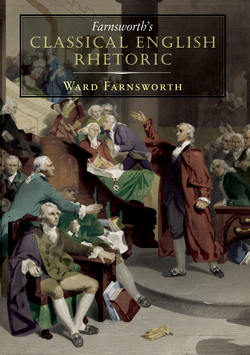Farnsworth's Classical English Rhetoric

Реклама. ООО «ЛитРес», ИНН: 7719571260.
Оглавление
Ward Farnsworth. Farnsworth's Classical English Rhetoric
PREFACE
I • REPETITION OF WORDS AND PHRASES. 1. Simple Repetition of Words and Phrases: EPIZEUXIS, EPIMONE, etc
2. Repetition at the Start: ANAPHORA
3. Repetition at the End: EPISTROPHE
4. Repetition at the Start and End: SYMPLOCE
5. Repeating the Ending at the Beginning: ANADIPLOSIS
6. Repetition of the Root: POLYPTOTON
II • STRUCTURAL MATTERS. 7. Parallel Structure: ISOCOLON
8. Reversal of Structure: CHIASMUS
9. Inversion of Words: ANASTROPHE
10. Using Extra Conjunctions: POLYSYNDETON
11. Leaving Out Conjunctions: ASYNDETON
12. Leaving Out Words: ELLIPSIS
III • DRAMATIC DEVICES. 13. Saying Things by Not Saying Them: PRÆTERITIO
14. Breaking Off in Midstream: APOSIOPESIS
15. Correcting Oneself: METANOIA
16. Rhetorical Uses of the Negative: LITOTES
17. Rhetorical Questions: EROTEMA
18. Asking Questions and Answering Them: HYPOPHORA & Anticipating Objections and Meeting Them: PROLEPSIS
BIBLIOGRAPHICAL NOTE
Отрывок из книги
EVERYONE SPEAKS and writes in patterns. Usually the patterns arise from unconscious custom; they are models we internalize from the speech around us without thinking much about it. But it also is possible to study the patterns deliberately and to learn more about how to use the ones that make the words they arrange more emphatic or memorable or otherwise effective. The most famous such patterns, known as rhetorical figures, were first identified and studied in ancient Greece and Rome. Most of them amount to departures from simple and literal statement, such as repeating words, putting words into an unexpected order, leaving out words that might have been expected, asking questions and then answering them, and so forth. Figures of these kinds amount to practical ways of working with large aesthetic principles – repetition and variety, suspense and relief, concealment and surprise, the creation of expectations and then the satisfaction or frustration of them – all as they apply to the composition of a simple sentence or paragraph. This book is meant as a help to those who wish to be on better terms with such techniques. It aims to show in detail what can be done with major rhetorical figures and the best of what has been done with them in English, to present the occasions for their use in systematic fashion, and to offer explanatory comments in moderation.
Rhetoric is a vast, old, and honorable discipline. It may be defined most broadly and simply as the use of language to persuade or otherwise affect an audience. The decline of rhetoric in our times is thus a much broader phenomenon than any mere decline in familiarity with figures of speech, but figures nevertheless are a good place to begin a study of the subject because they tend to be easy to explain, instructive to examine, and frequently useful. It certainly is possible to write well without rhetorical figures, but most of the best writers and speakers – the ones whose work has stood up the longest – have made important use of them, and figures tend to show up often in utterances that are long remembered. The point is not that figures are useful for writing things that one hopes will last, for writing anything in that hope is almost always a mistake. The point, rather, is that durability is one measure of the excellence of a style and the value of the techniques that it employs. It helps us think about quality in ways more interesting than asking what panders best to the fashions of the moment.
.....
I have shown that slavery is wicked – wicked, in that it violates the great law of liberty, written on every human heart – wicked, in that it violates the first command of the decalogue – wicked, in that it fosters the most disgusting licentiousness – wicked, in that it mars and defaces the image of God by cruel and barbarous inflictions – wicked, in that it contravenes the laws of eternal justice, and tramples in the dust all the humane and heavenly precepts of the New Testament.
Douglass, speech at Rochester (1850)
.....